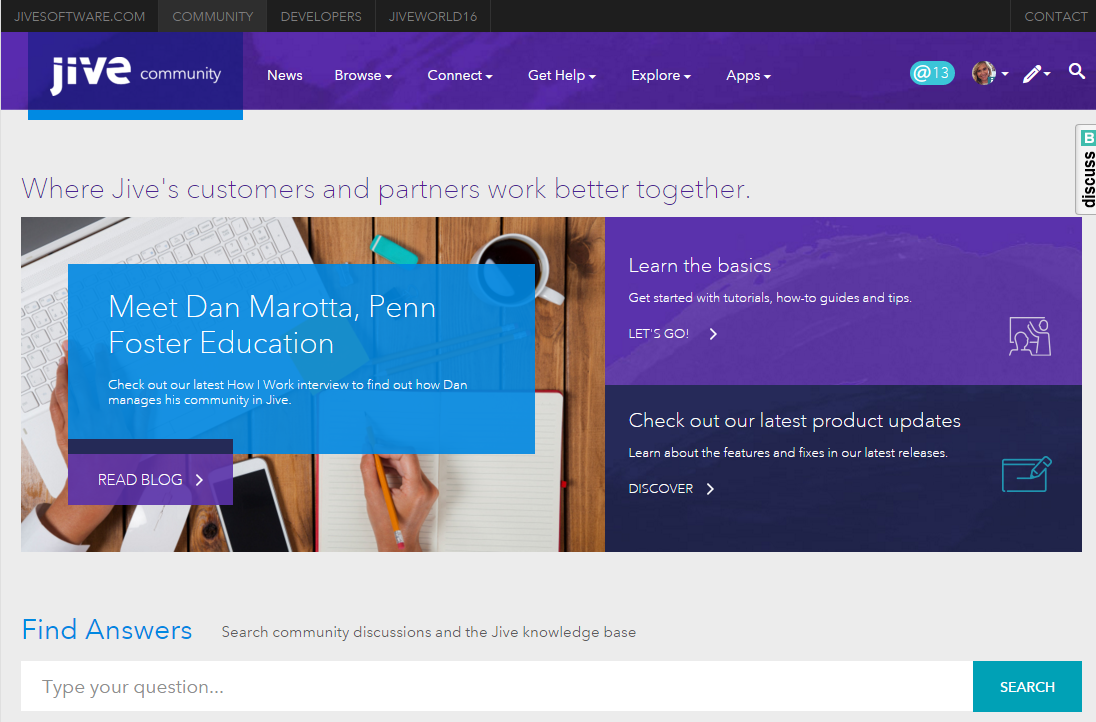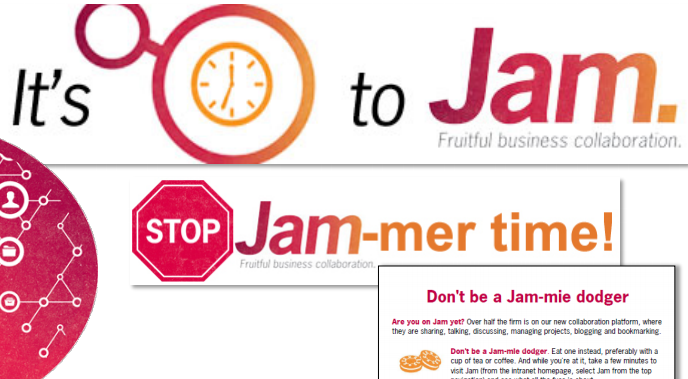See how companies like lululemon, Grant Thornton and Jive are incorporating their culture into their online communities
Every organization has a culture—embodied by the things that its members think, say and do. This is conveyed in their mission, vision and values, in the behaviors they reward, how things get done, what people pay attention to, the stories they tell, and their customs and rituals. When Jive’s Professional Services team works with a customer to create and launch a new community, we’re careful to make sure that what we design and build matches their culture. A good cultural fit is critical for success—if the tone of the community differs from the organization’s cultural norms, and the purpose doesn’t clearly map to its goals, it can be perceived as uncomfortable and inauthentic, which in turn makes people reluctant to get involved. A very formal and traditional company where people closely guard their expertise would struggle with leaping into a “working out loud” community, where everyone shares their work in progress and comments on their co-workers’ contributions. Equally, if a more relaxed and open organization launched a formal community with very restrictive rules and boundaries, they’d find it hard to inspire people to participate.
So what does it actually mean to build a community that matches and reflects your organization’s culture? It’s not just about choosing an appropriate community name and theming it according to your brand guidelines—although that IS important. It’s also about making sure that the values that define your organization, and the ways that you interact with your customers and with each other are reflected throughout the community—in the content and destinations your users find there, in the way that people behave and interact there, and in the way that you garden and guide the community.
This is something that Jive customer lululemon has done brilliantly. In their inspiring talk at JiveWorld ’14, they described different ways in which their culture is reflected and nurtured in two of their communities—their global intranet youlu and their customer ideas community heylululemon.
In youlu, their culture and their goal of empowering their employees is reflected in a number of different ways. A really important part of their culture is that each employee creates and shares their Vision and Goals, which not only encapsulates their career goals, but also their personal aspirations—so they built this right into the community, where everyone shares their 1, 5 and 10 year vision and goals in their profile. They’ve made space in youlu for people to gather and talk about topics that lululemon employees are passionate about, for example in their sustainability forum. And their CEO, Laurent Potdevin is as accessible in the community via his blog and live Q&A sessions as he is in real life, where he does a bi-weekly summer hike up Grouse Mountain in Vancouver, and any employee that wants to join this 5am expedition can do so!
In heylululemon, their goal was to build trust with customers, or guests as they’re called at lululemon. Guests in the community have a direct connection to members of the lululemon team, from Product Manager Britt who shares a weekly sneak peek into upcoming products, to SVP of US Retail Paul, who responded directly in the community to a dissatisfied guest, which in turn led to a phone conversation.
So what are some of the practical steps you can take to reflect your culture in your own community? Here are some things I’ve seen work well for our most successful customers.
Show your personality
When you design a new community, make sure you properly understand the tone you want to establish and the feelings you want to evoke. Your community should have some personality—but what personality? Formal or casual? Conventional or quirky? You might find it helpful to brainstorm a list of adjectives that you’d want people to use when they describe the community, and use that as inspiration for your branding. Many customers allow their users to suggest and vote on a community name as part of their launch activities. This gets people engaged and is a really effective way of choosing a name that resonates well with people and accurately reflects your culture. You can carry this personality throughout the community, via the name, theming and homepage design. This includes the content you display on your landing page—what are you asking people to do and what language are you using when you do so? The Jive Community homepage is a good example of this:

It follows our brand guidelines and colors, and has a simple, clear name. The homepage tells you that:
- We’re focused on our product and enabling our customers (via the calls to action)
- We know our audience (Your track)
- You’ll find lots of practical help here (“Find Answers” and featured “How-to” resources)
What you say matters
The way you talk about your community has enormous impact. Your communications and marketing content and strategy are often the first experience people will have of your community, and it’s a great way to set the tone. Grant Thornton did a great job of this with their community ‘Jam.’ They used the jam theme in all their communications, from their strapline—Fruitful business collaboration—to their biscuit-themed marketing campaign:

You also have an opportunity to reflect your culture in the training and help content you create, and even how you deliver it. Some customers find classroom training to be a good fit for them, while others find short video clips, drop-in “office hours” or pop-up genius bar better suit their workstyle. You should also consider the tone you take with your community guidelines. Many customers use these as a more informal supplement to their legal Terms & Conditions, and they are a great way to establish the kind of tone, interaction and culture you want to see.
Places and content
You can reflect and reinforce your culture through the places and content within your community. A great way to do this is by creating and encouraging affinity groups—places people can gather to talk about things that are important to them, whether that’s volunteering, cooking, home electronics or their favorite sports teams. These might not have anything to do with the main topic and goals of your community, but they are an extremely effective way for people to bond, and they also provide a safe and simple way for people to take their first steps to engaging and getting involved.
Customers with a virtual ‘Water Cooler’ often find that it’s not only one of the most popular places in their community, but that it draws the most diverse user base, and is a great way to surface topics of interest and take the temperature of a community.
Many customers create a glossary where people can crowdsource a list of terms and definitions that are important to the organization. These range from the formal to the irreverent. Our own ‘Jiveopedia’ in our internal community, Brewspace, provides a crash course in getting to know Jive culture, history and language.
On your best behavior
So much of the tone of your community is made up of interactions and the way people behave there, so it’s crucial to cultivate and reward the behaviors that best reflect the culture you want to establish. When people demonstrate these behaviors, reward them accordingly. The best way to do this is by giving them special treatment—usually not a monetary reward, but something else that is important to them. Popular tactics include:
- Recognition – feature them prominently in the community on the homepage, in a group dedicated to their peers, or in a special recognition and reward group
- Acknowledge their expertise – give them an expert badge, post an interview with them featuring their expertise, ask them to manage an expert group in the community
- Special access – give them early access to a product or service, invite them to an exclusive event, give them limited edition swag
- Just say thanks – ask a leader to post about them or @mention them, give them a virtual high five, send them a thank you note
There's no limit
These are just some of the examples of how you can reflect your culture in your community—really you are only limited by your imagination. At Jive, we live, work and play in our internal community, Brewspace, and every aspect of it reflects our culture, right down to the way we complete our profiles and use our skills and expertise feature.
Get more practical tips and tricks from our Senior Enterprise Community Manager, Kosheno Moore, in her posts 5 Tips All New Community Managers Should Consider in the First 60 Days and Nurturing an Internal Community Culture as a New Community Manager.
GET A PERSONALIZED DEMO
See how Jive works. Request a personalized demo.
See for yourself how Jive can drive productivity and engagement across your organization. Get a free personalized demo.